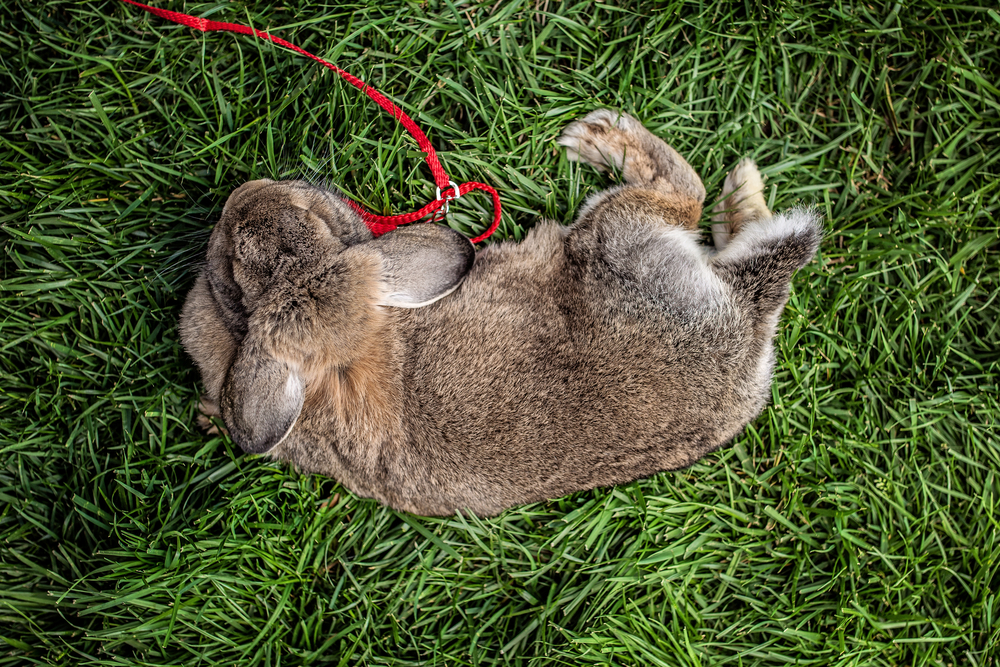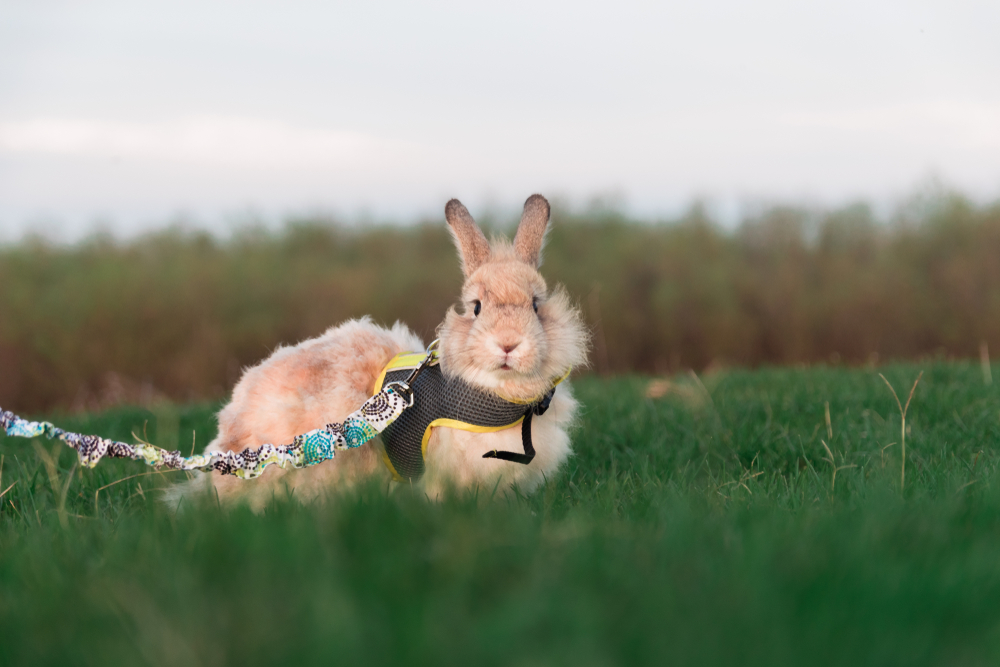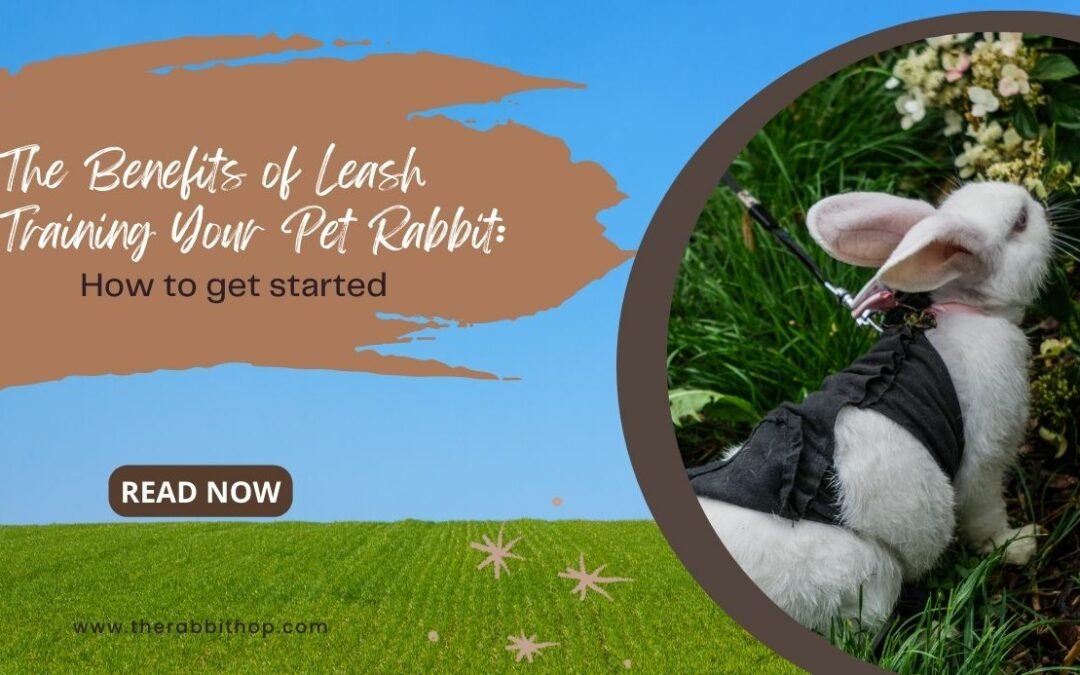Leash training is not just for dogs anymore. It is becoming increasingly popular to leash train rabbits for their safety and enrichment. In this article, we will discuss the benefits of leash training your pet rabbit, how to get started, and tips for successful training. We will also address common mistakes to avoid and the factors to consider when determining whether your rabbit is a good candidate for leash training.
Related: Litter Train Your Rabbit- Easy Tips

Introduction to Leash Training for Rabbits
Leash training involves teaching your pet rabbit to walk on a harness and leash. It allows rabbits to explore the outdoors safely and provides them with much-needed exercise and mental stimulation. Leash training also helps rabbits become more comfortable with handling and human interaction.

Why Leash Training Your Rabbit is Beneficial
Leash training has several benefits for rabbits. First, it allows them to safely explore the outdoors. Rabbits are natural explorers and enjoy investigating new environments. Leash training gives them the opportunity to do so while keeping them safe from predators and other dangers.
Second, leash training provides rabbits with exercise and mental stimulation. Rabbits need daily exercise to maintain their health and well-being. Leash training allows them to move around and explore their surroundings, which can help prevent boredom and behavioral problems.
Finally, leash training helps rabbits become more comfortable with handling and human interaction. Rabbits can be skittish and fearful, but leash training can help them become more confident and trusting.

Understanding Your Rabbit’s Behavior and Personality
Before you start leash training your rabbit, it is important to understand their behavior and personality. Rabbits are prey animals, which means they are naturally cautious and easily frightened. They also have different personalities, with some being more outgoing and adventurous than others.
It is important to take your rabbit’s temperament into account when deciding whether to leash train them. If your rabbit is extremely timid or fearful, it may not be a good candidate for leash training. However, if your rabbit is curious and outgoing, they may enjoy leash training and benefit from the exercise and mental stimulation it provides.

How to Get Started with Leash Training Your Rabbit
To get started with leash training, you will need a harness and leash designed specifically for rabbits. These can be found at pet stores or online. It is important to choose a harness that fits your rabbit properly and is comfortable for them to wear.
Once you have the necessary equipment, you can start introducing your rabbit to the harness and leash. This should be done gradually and in a positive, low-stress environment. It is important to use positive reinforcement techniques, such as treats and praise, to encourage your rabbit to accept the harness and leash.
Which type of rabbit harness to consider
There are a few different types of rabbit harnesses available, each with its own advantages and disadvantages.
- Halter harnesses: These harnesses are made of a single strap that goes around the rabbit’s neck and chest. They are easy to put on and take off, but they can be uncomfortable for rabbits and can put pressure on their necks if they pull too hard.
- Vest harnesses: These harnesses are made of two straps that go around the rabbit’s chest and back. They are more comfortable for rabbits than halter harnesses, but they can be more difficult to put on and take off.
- Combination harnesses: These harnesses combine features of both halter and vest harnesses. They are easy to put on and take off, and they are comfortable for rabbits.
When choosing a rabbit harness, it is important to consider the size and breed of your rabbit, as well as their personality. Rabbits that are easily spooked or tend to pull may be better suited for a halter harness, while more relaxed rabbits may be able to handle a vest harness. It is also important to make sure that the harness is adjustable so that it fits snugly but comfortably.
In addition to the type of harness, there are a few other things to keep in mind when walking a rabbit. First, it is important to start slowly and gradually increase the amount of time you spend walking. Second, be sure to choose a safe area to walk your rabbit, such as a park or a quiet neighborhood. Third, be aware of your surroundings and be on the lookout for potential hazards, such as cars, dogs, and other animals.
With a little planning and preparation, you can enjoy many happy walks with your furry friend.

Steps to Leash Train Your Rabbit
- Choosing the Right Leash and Harness: As mentioned earlier, you will need a harness and leash designed specifically for rabbits. Make sure that the harness fits your rabbit properly and is comfortable for them to wear.
- Introducing the Leash and Harness to Your Rabbit: Allow your rabbit to sniff and investigate the harness and leash before putting it on them. Once they are comfortable with the equipment, place the harness on your rabbit and adjust it so that it fits snugly but not too tightly. Then, attach the leash to the harness and let your rabbit drag it around for a few minutes.
- Practicing Indoors: Once your rabbit is comfortable wearing the harness and leash, you can start practicing indoors. Allow your rabbit to explore a small, safe area while on the leash. Use positive reinforcement techniques to encourage your rabbit to walk on the leash and to praise them for their progress.
- Moving Outdoors: Once your rabbit is comfortable walking on the leash indoors, you can start taking them outside for short walks. Choose a quiet, safe area and keep your rabbit on a short leash. Use positive reinforcement techniques to encourage your rabbit to walk on the leash and to praise them for their progress.

Tips to leash train your pet rabbit successfully
- Use Positive Reinforcement: Positive reinforcement techniques, such as treats and praise, are essential for successful leash training. Reward your rabbit for their progress and encourage them to continue walking on the leash.
- Be Patient: Leash training can take time and patience. It is important to go at your rabbit’s pace and not to rush them. Allow them to explore and become comfortable with the equipment before moving on to more challenging situations.
- Be Consistent: Consistency is key when leash training your rabbit. Try to practice regularly and use the same techniques each time. This will help your rabbit become more comfortable with the process and progress more quickly.
- Keep in mind your rabbit’s safety is most important. The rabbit harness needs to fit well. Use a soft harness and avoid pulling on the rabbit’s neck.
- Watch for your rabbit’s reaction and be ready to stop the training sessions when necessary.

Common Mistakes to Avoid When Leash Training Your Rabbit
- Using the Wrong Equipment: Using equipment that is too big or too small for your rabbit can be uncomfortable and even dangerous. Make sure that you choose equipment designed specifically for rabbits and that it fits your rabbit properly.
- Rushing Your Rabbit: It is important to go at your rabbit’s pace when leash training. Rushing them or pushing them too hard can be stressful and counterproductive.
- Using Negative Reinforcement: Negative reinforcement techniques, such as punishment or scolding, can be damaging to your rabbit’s trust and confidence. Use positive reinforcement techniques instead.
- Conduct your training process in an area without other animals present. Even a buddy bunny might cause him to lose attention. Often pet rabbits are best leash trained in an area without distractions.

Can All Rabbits be Leash Trained? Factors to Consider
Not all rabbits are good candidates for leash training. Factors to consider include your rabbit’s temperament, age, and health. If your rabbit is extremely timid or fearful, it may not be a good candidate for leash training. Similarly, if your rabbit is very young or has health problems, leash training may not be appropriate.

Training a young Bunny vs. Training an adult Rabbit – Differences and Similarities
Training a young rabbit is similar to training an adult rabbit, but there are some differences to consider. Young bunnies may be more easily distracted and may have shorter attention spans. Keep training sessions should be shorter and more frequent. Younger rabbits may also be more energetic and playful, which can make leash training more challenging.
Frequently Asked Questions About Rabbit Leash Training
Is leash training safe for rabbits?
Yes, leash training can be safe for rabbits if done properly. It is important to use equipment designed specifically for rabbits and to use positive reinforcement techniques to encourage your rabbit to accept the harness and leash.
How long does it take to leash train a rabbit?
The amount of time it takes to leash train a rabbit varies depending on the rabbit’s temperament and personality. It may take a few days or a few weeks to fully leash train a rabbit.
Can you train a rabbit to walk on a leash without a harness?
No, it is not recommended to walk a rabbit on a leash without a harness. Rabbits can easily slip out of collars or other types of leashes, which can be dangerous. Also, a collar can cause permanent injury to the rabbit’s neck. It might even cause death.
The Importance of Bunny and Rabbit Leash Training for Their Safety and Enrichment
Leash training is a great way to provide your pet rabbit with exercise, mental stimulation, and the opportunity to explore the outdoors safely. It can also help rabbits become more comfortable with handling and human interaction. By following the steps outlined in this article and using positive reinforcement techniques, you can successfully leash train your rabbit and enjoy all the benefits it provides.
Ready to Start leash training sessions with your rabbit?
If you are considering leash training your rabbit, make sure to take your rabbit’s temperament and personality into account. Use positive reinforcement techniques and be patient and consistent. With time and practice, you can successfully leash train your rabbit and provide them with the exercise and enrichment they need.
You Might Also Like



